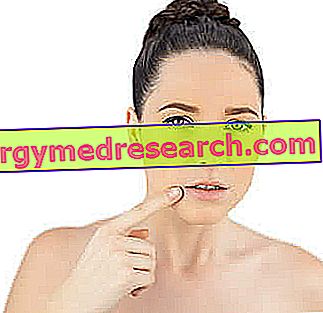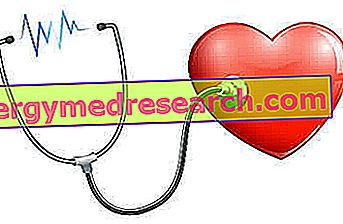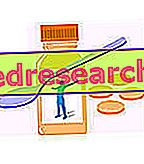The angular cheilitis or boccarola is a small cut, sometimes similar to an abrasion, which occurs at the level of the labial commissures.

The symptoms are those typical of inflammation:
- Redness.
- Pain (especially when opening the mouth).
- Sometimes swelling.
- Skin wear.
Angular cheilitis occurs mainly in children, the elderly and people who exhibit predisposing factors.
What to do
- Treat a possible candida infection (candidiasis). It's possible to use:
- Drugs.
- In association, also natural remedies (phytotherapic).
- In the case of celiac disease, comply with the hygienic rules for the exclusion of gluten.
- It is important to follow the celiac diet especially in presence of gastrointestinal symptoms, generalized malabsorption and other symptoms of celiac disease.
- Compensate for any nutritional deficits. Hypovitaminosis and mineral deficiencies are particularly involved:
- Vitamin B12 deficiency (cobalamin).
- Iron deficiency.
- It is important to compensate for the deficiency of iron and cobalamin especially in co-presence with anemia (sideropenic, pernicious or both).
- Vitamin PP deficiency (niacin).
- It is important to compensate for the lack of niacin, especially in presence of dermatitis of the arms and neck, gastrointestinal disorders, anxiety and depression.
- Keep the skin soft by using specific emollient and even antimicrobial creams.
- Avoid subjecting the commissions to intense heat, using protective creams during exposure to the summer sun.
- Avoid subjecting the skin to intense cold, covering yourself in the winter months.
- Avoid subjecting the corners of the mouth to abrasion or other physical stimuli.
- Avoid subjecting facial skin to chemical stress (eg solvents).
What NOT to do
- Increase the infection risk of candida or relapses.
- Ignore the celiac condition by eating foods with gluten.
- Follow diets deficient in iron and / or vitamin B12 and / or niacin.
- Dry the labial commissures.
- Subject the skin of the face to intense heat, without using protective creams during exposure to the summer sun.
- Subject the skin of the face to intense cold, without covering itself in the winter months.
- Subject the corners of the mouth to abrasion or other physical stimuli.
- Subject the skin of the face to chemical stress (solvents, etc.).
What to eat
- To guarantee the intake of iron, especially haem and ferrous (2+), it is necessary to eat:
- Muscle tissue: both of terrestrial and aquatic animals: horsemeat, bovine, swine, avian, fish, whole molluscs (also land snails), whole crustaceans etc.
- Eggs: any, especially the yolk.
- Offal and fifth quarter: mainly spleen and liver, but also marrow, diaphragm, heart, etc.
- To ensure the supply of vitamin C, citric acid and fructose (very useful for intestinal absorption of iron), it is necessary to eat:
- Sweet and sour fruit: lemon, grapefruit, orange, mandarin, clementine, kiwi, cherries, strawberries etc.
- Vegetables and tubers: parsley, pepper, lettuce, spinach, radicchio, broccoli, tomato, potato etc.
NB . Vitamin C or ascorbic acid is a thermolabile molecule and is degraded by cooking. This means that to ensure their intake it becomes necessary to consume many raw foods. Moreover, being involved in the absorption of low-available iron, it is important that it is taken with specific foods.
- To ensure the intake of vitamin B12 (cobalamin) it is necessary to eat:
- The same foods source of heme iron;
- Remember that certain foods may contain anti-nutritional principles that reduce iron absorption. To reduce its content, you need to practice:
- Soaking.
- Fermentation (yeasts or bacteria).
- Cooking.
NB . Since cooking inhibits the nutritional principles but limits the availability of thermolabile vitamins, it is recommended that raw and cooked foods are equally present in the diet. It is advisable to reserve heat treatment especially for legumes and cereals, while most fruits and vegetables could be eaten raw.
- To guarantee the supply of vitamin PP (niacin) it is sufficient to respect a varied but balanced diet. It is contained in: cereals, legumes, meats, eggs, fishery products and offal.
- In addition to the above, to help the immune system it is advisable to also consume:
- Probiotic foods.
- Foods rich in vitamin D and E.
- Foods rich in magnesium, zinc and selenium.
- Lysine and glycine amino acid foods.
- Foods rich in omega 3.
- Foods rich in polyphenolic antioxidants.
What NOT to Eat
- In the case of celiac disease, avoid gluten-containing cereals, derivatives and recipes that contain them. Cereals containing gluten are: wheat, spelled, spelled, rye, oats, sorghum and barley.
- It is also advisable to avoid:
- Monothematic diets.
- Vegan diet.
- Diet free of vegetables and vegetables.
- Diets based solely on:
- Cooked foods.
- Preserved foods.
- Abolishing alcohol abuse: compromises metabolism, intestinal absorption and general health.
Natural Cures and Remedies
- To be associated with drug therapy, some herbal remedies are:
- Essential oils of mint, oregano, thyme and maleleuca, to be taken in the form of opercula.
- Plants with adaptogenic / immunostimulatory action:
- Uncaria tormentosa (Uncaria tomentosa)
- Echinacea (Echinacea purpurea)
- Curcuma (Curcuma longa)
- Antibacterial drugs:
- Especially Propolis.
Pharmacological care
- Azole drugs for topical use:
- Undecylenic acid, 12-25% (for example Anti-Fungal, Elon Dual Defense).
- Clotrimazole, 1% (eg Canesten, Mycelex).
- Miconazole, 2% (eg Cruex, Micatin).
- Azole drugs for systemic use to be taken by mouth:
- Itraconazole (eg Sporanox, tablets).
- Polyenic antifungal drugs to be taken by mouth:
- Amphotericin B (eg Abelcet).
- Nystatin (eg Mycostatin).
- Echinocandin drugs to be taken by mouth:
- Cancidas (eg Caspofungin).
- Mycamine (for example Micafungin).
Prevention
- Avoid contagion (hygiene rules) or recurrences of candida.
- Increase the intake of vitamin PP or niacin with diet and supplements.
- Increase your intake of iron and vitamin B12 or cobalamin with diet and supplements.
- In case of celiac disease do not consume foods with gluten.
- Protect the face skin from physical and chemical stress (dental appliances, abrasions, intense cold, solvent fumes, etc.).
Medical Treatments
There are no medical treatments against cuts at the corners of the mouth.



